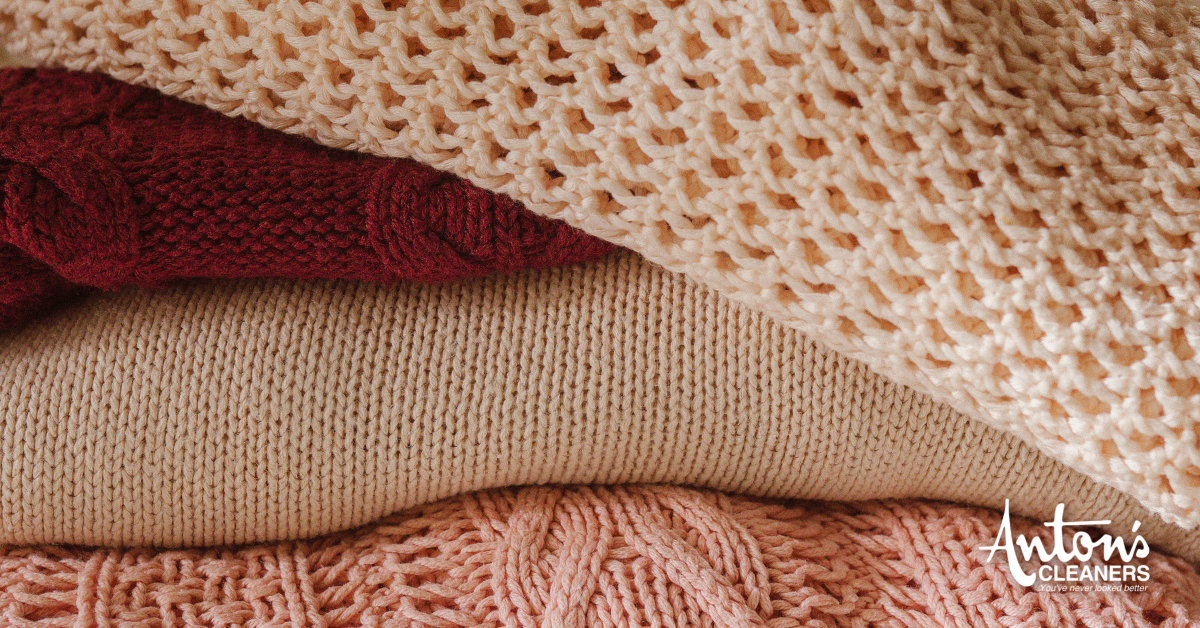At Home Cleaning: Sweaters and Their Many Fibers
December 31, 2022 11:59 pm Sweaters come in many shapes, sizes, and fiber content. Each type of fiber can present different challenges when in the cleaning process. Here are some tips to help you successfully clean sweaters at home without causing damage.
Sweaters come in many shapes, sizes, and fiber content. Each type of fiber can present different challenges when in the cleaning process. Here are some tips to help you successfully clean sweaters at home without causing damage.
ACRYLIC
Acrylic knit sweaters are often difficult to distinguish from wool or other fiber types. For this reason, paying attention to the care label and content is especially important. If the label suggests precautions, or if you notice “acrylic” is noted on the fiber content label, special handling will be required.
Acrylic is a thermoplastic fiber. This means it can be affected by heat, and the fibers may be stretched due to high temperatures. For this reason, avoid high temperatures in drying or steam pressing.
Lay flat to dry or, if the care label recommends, tumble dry at low temperatures.
ANGORA
Angora rabbit hair is blended with wool and synthetic fibers to create a very soft fabric. The biggest problem with Angora? Shrinkage.
Hand washing is recommended and will be less damaging. If machine washing is recommended on the care label, use a mild detergent (alkaline detergents can damage the angora fibers).
Even machine washing on a delicate cycle causes more shrinkage than hand washing. Lay flat to dry.
CAMEL’S HAIR/CASHMERE/MOHAIR
Camel’s hair, cashmere, and mohair are soft, touchable wools. Camel hair is a fabric made from the hair of a camel, sometimes blended with wool. Fibers from the camel family include camel hair, alpaca, guanaco, llama, and vicuna. All are soft and very durable.
Cashmere and mohair both come from goats and are often blended with wool or synthetic fibers.
Due to their construction, most sweaters made of these fibers are “dry clean only.” The most common problems with these fabrics include shrinkage and matting/pilling, especially in areas of wear such as the collar, elbows, or underarms.
CHENILLE
Chenille yarns resemble a pipe cleaner or caterpillar and have a pile-like surface. (Fun Fact: Chenille is French for caterpillar.)
Chenille yarns are used in woven and knit constructions and are popular for use in apparel and home furnishings.
On loosely woven or knitted sweaters and other apparel, the yarns tend to snag or pull easily, often initiated by normal rubbing or friction of the material. The necessary agitation of cleaning further aggravates the damage.
For washable chenille articles, hand washing may be safer than machine washing, even if the article is labeled as such. Machine washing, even on a gentle cycle, can cause excessive fabric damage. After washing, lay the sweater flat to dry.
WOOL
Wool is a protein fiber spun from sheep’s hair and is popular because it is durable, comfortable, and an excellent insulator.
Wool requires special handling in both dry cleaning and laundering. When the care label is not followed, shrinkage may result.
If the care label suggests hand washing, use cool water and mild detergent. Alkaline detergents and chlorine bleach should be avoided. After soaking for up to five minutes, rinse thoroughly and squeeze out excess water. Do not wring or twist wool.
If the label suggests machine washing, use the gentle cycle only.
Always lay the wool sweater flat to dry, away from sunlight and direct heat.
If your wool sweater has a stain or “dry clean only” label, it is best to leave clothing care to the professionals.
Whatever fabric your sweaters are made of, Anton’s is happy to provide the highest quality care. Our expertly trained staff follow clothing care labels and regularly participate in ongoing training of the latest fabrics and techniques.
Save this month!
Through January, you can save 25% off on sweaters and scarves! Print your coupon here.
Want a coupon for 50% off sweaters and scarves? Sign up as a VIP Express customer at one of our 37 convenient locations, and we’ll send the exclusive 50% VIP coupon to your email.